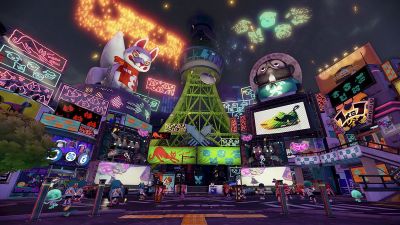Inkopolis Plaza: Difference between revisions
mNo edit summary |
mNo edit summary |
||
| Line 5: | Line 5: | ||
Inkling culture in Splatoon is part of [[:Category:Japanifornia]]. The urban-industrial Graffiti Town setting of [[Inkopolis]] features elements of both Tokyo (the Shibuya-inspired [[Inkopolis Plaza] and New York City (the Times Square-inspired [[Inkopolis Square]]), with other cities like Splatsville following suit. Japanese influences are additionally evident in stuff like some symbolism and the traditional Japanese clothing shown by some characters (notably Marie through most of Splatoon 2), while American influence comes across through the Totally Radical atmosphere inspired by late 90s/early 00s American pop culture (80s pop culture for Splatoon 2's Octo Expansion). | Inkling culture in Splatoon is part of [[:Category:Japanifornia]]. The urban-industrial Graffiti Town setting of [[Inkopolis]] features elements of both Tokyo (the Shibuya-inspired [[Inkopolis Plaza] and New York City (the Times Square-inspired [[Inkopolis Square]]), with other cities like Splatsville following suit. Japanese influences are additionally evident in stuff like some symbolism and the traditional Japanese clothing shown by some characters (notably Marie through most of Splatoon 2), while American influence comes across through the Totally Radical atmosphere inspired by late 90s/early 00s American pop culture (80s pop culture for Splatoon 2's Octo Expansion). | ||
[[:Category: Japanifornia]] | |||
[[Category: Culture]] | |||
[[Category: Fictional]] | |||
Revision as of 17:47, 19 August 2022

Inkopolis Plaza from the game Splatoon is an obvious mix of Japan and the West.
Inkling culture in Splatoon is part of Category:Japanifornia. The urban-industrial Graffiti Town setting of Inkopolis features elements of both Tokyo (the Shibuya-inspired [[Inkopolis Plaza] and New York City (the Times Square-inspired Inkopolis Square), with other cities like Splatsville following suit. Japanese influences are additionally evident in stuff like some symbolism and the traditional Japanese clothing shown by some characters (notably Marie through most of Splatoon 2), while American influence comes across through the Totally Radical atmosphere inspired by late 90s/early 00s American pop culture (80s pop culture for Splatoon 2's Octo Expansion).